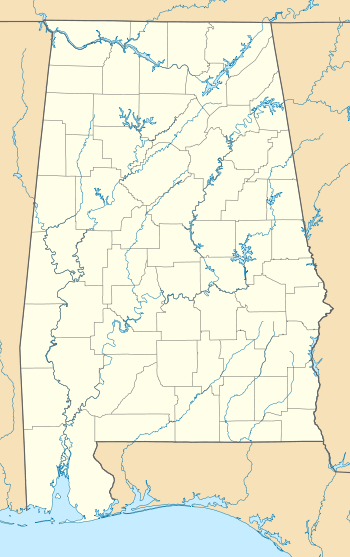Joseph M. Farley Nuclear Generating Station
| Joseph M. Farley Nuclear Generating Station | |
|---|---|
 Location of Joseph M. Farley Nuclear Generating Station in Alabama | |
| Country | United States |
| Location | Dothan, Alabama |
| Coordinates | 31°13′23″N 85°6′42″W / 31.22306°N 85.11167°WCoordinates: 31°13′23″N 85°6′42″W / 31.22306°N 85.11167°W |
| Status | Operational |
| Construction began | 1970 – |
| Commission date |
Unit 1: Dec. 1, 1977 Unit 2: July 30, 1981 |
| Construction cost | ~$1.57 billion |
| Owner(s) | Alabama Power |
| Operator(s) | Southern Nuclear |
| Nuclear power station | |
| Reactor type | pressurized water reactor |
| Reactor supplier | Westinghouse |
| Power generation | |
| Units operational |
1 x 874 MWe 1 x 883 MWe |
| Capacity factor |
1 x 93.5% 1 x 93.8% |
| Average generation | 14,282 GWh |
|
Website http://www.southerncompany.com/about-us/our-business/southern-nuclear/farley.cshtml | |
The Joseph M. Farley Nuclear Generating Station is located near Dothan, Alabama in the southern United States. The twin-unit nuclear power station sits on a largely wooded and agricultural 1,850-acre (750 ha) site along the Chattahoochee River, approximately 5 miles (8.0 km) South of Columbia, Alabama in Houston County.
History
The plant is named after the late Joseph McConnell Farley, an American attorney born in Birmingham, Alabama who became president of Alabama Power (owner of the facility) from 1969 to 1989 and was later CEO of Southern Nuclear Operating Company; both companies are subsidiaries of Southern Company.
Construction of the plant began in 1970. Fluor Corporation of Irving, Texas was the general contractor. Unit 1 achieved commercial operation in December 1977. Unit 2 began commercial operation in July 1981. The total cost of the plant was about $1.57 billion. On May 12, 2005, the Nuclear Regulatory Commission (NRC) approved license renewal applications for both reactors at the site. Unit 1's extended operating license is set to expire on June 25, 2037 and Unit 2's on March 31, 2041.
Technology
This plant has two Westinghouse reactors.
- Unit 1: 2,775 MWt
- Unit 2: 2,775 MWt
Both units are three-loop pressurized water reactors. The facility is cooled using six mechanical draft cooling towers supplied by water from the Chattahoochee River.[1]
Ownership
- Farley, Unit 1
- Owner = Alabama Power Company (100 percent).
- Operator (Licensee) = Southern Nuclear Operation Company.
- Farley, Unit 2
- Owner = Alabama Power Company (100 percent).
- Operator (Licensee) = Southern Nuclear Operation Company.
Surrounding population
The NRC defines two emergency planning zones around nuclear power plants: a plume exposure pathway zone with a radius of 10 miles (16 km), concerned primarily with exposure to, and inhalation of, airborne radioactive contamination, and an ingestion pathway zone of about 50 miles (80 km), concerned primarily with ingestion of food and liquid contaminated by radioactivity.[2]
The 2010 U.S. population within 10 miles (16 km) of Farley was 11,842, an increase of 8.0 percent in a decade, according to an analysis of U.S. Census data for msnbc.com. The 2010 U.S. population within 50 miles (80 km) was 421,374, an increase of 6.1 percent since 2000. Cities within 50 miles include Dothan (17 miles to city center).[3]
Seismic risk
The NRC's estimate of the risk each year of an earthquake intense enough to cause core damage to the reactor at Farley was 1 in 35,714, according to an NRC study published in August 2010.[4][5]
References
- ↑ http://www.eia.gov/nuclear/state/alabama/index.cfm EIA State Nuclear Profiles; Alabama Nuclear Profile 2010 Accessed 4 August 2013
- ↑ http://www.nrc.gov/reading-rm/doc-collections/fact-sheets/emerg-plan-prep-nuc-power-bg.html
- ↑ Bill Dedman, Nuclear neighbors: Population rises near US reactors, msnbc.com, April 14, 2011 http://www.msnbc.msn.com/id/42555888/ns/us_news-life/ Accessed May 1, 2011.
- ↑ Bill Dedman, "What are the odds? US nuke plants ranked by quake risk," msnbc.com, March 17, 2011 http://www.msnbc.msn.com/id/42103936/ Accessed April 19, 2011.
- ↑ http://msnbcmedia.msn.com/i/msnbc/Sections/NEWS/quake%20nrc%20risk%20estimates.pdf
External links
- "Plant Farley". Southern Company. 2008. Archived from the original on October 26, 2008. Retrieved 2008-11-17.
- "(Joseph M.) Farley Nuclear Power Plant, Alabama". Energy Information Administration, U.S. Department of Energy (DOE). August 22, 2008. Retrieved 2008-11-17.
- "Farley 1 Pressurized Water Reactor". Operating Nuclear Power Reactors. U.S. Nuclear Regulatory Commission (NRC). February 14, 2008. Retrieved 2008-11-17.
- "Farley 2 Pressurized Water Reactor". Operating Nuclear Power Reactors. NRC. February 14, 2008. Retrieved 2008-11-17.